The Madness has set firmly on the brain as the Camera Flu continues un-abated.
I was curious how a Nikon Nikkor 300mm f/4.5 H might compare against the much more recent and optically sophisticated Canon 100-400mm L f/4.5-5.6 super zoom.
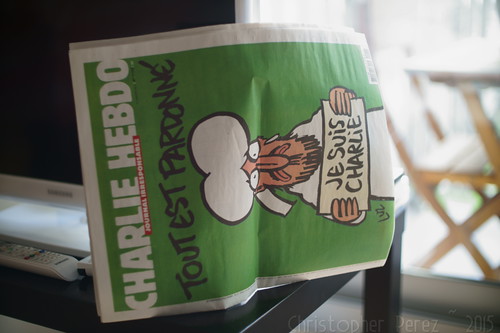
Why the curiosity? Well, because, on a whim I picked up one of the
aforementioned Nikon 300mm non-ED lenses for 100Euro. It's in tres bon etat
and came with the proper caps for both ends and the original carrying
case. I'm a sucker and an easy mark for old manual focus lenses in
excellent condition.
Checking the serial number of the lens I see that I was made during the early 1970's. The H model optic preceded Nikon's introduction of their extra low dispersion glass example by at least 3 years. Commenters across the 'net seem to rave about the 300mm ED, but not much enthusiasm is expended over the H. Well, as I said, I'm a sucker for a good looking lens.
The old Nikkor is nearly as heavy as the Canon L, though this is nicely offset by the smaller diameter lens barrels. I've found that a smaller lens size makes a lens easier for me to work with, even if the weight is similar to something with a large diameter barrel.
Being a fixed focal length lens, the Nikon is of course not as flexible the Canon zoom. But, since the Sony A6000 is APS-C and since I have a Lens Turbo II focal length reducer and a standard straight-thru Nikon to E-mount adapter I have two focal lengths to choose from when using the Nikkor - 300mm f/4 and 216mm f/3.2.
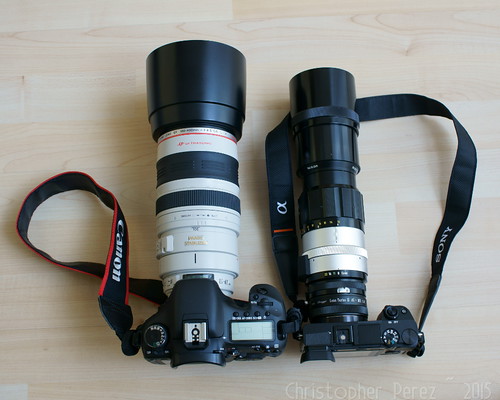
Assuming for a moment that Sony introduces an in-body IS APS-C camera that solves the no-IS problem in using old lenses, the biggest thing I in the Sony/Nikkor kit give up is AF. I've come to love AF as it's most of the time more accurate than I am. The question is how accurate can I be at focusing the Nikkor? Would I be happy with the results?
The comparison setup was as follows -
The results are...
[The following image links to my Flickr page. Look at this a full resolution to properly compare the various image sections.]
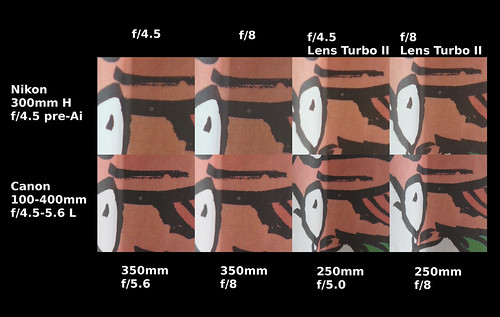
My observations include -
Nikon single-coated lens images are slightly lower contrast than the Canon zoom. However, it was very easy to match the contrast of the Canon lens in processing.
Canon's Live View AF system was a rather hit-or-miss affair. This is easily seen in the image comparisons. To think I've trusted the Canon AF system in the over 5 years I've owned the 7D. Having said that, using a (mostly) accurate very high speed AF system tied to image stabilization and focal-length flexibility makes for a very powerful kit.
If I can accurately focus my manual focus lenses the Sony A6000 offers 11fps burst rate whereas the 7D waltzes along at 8fps. Am I good enough to track and accurately focus moving targets? Time will tell.
The higher resolution Sony sensor (24mpixel vs Canon's 18mpixel) gives me a to be expected increase in the amount of information that can be used in the image file. The Sony file details are gorgeous and easy to work with. The sensor is the resolution limiting fact. Lenses typically out-resolve a sensor from wide open down through f/11.
From wide open, the Nikon 300mm f/4.5 H pre-Ai single-coated ancient as the hills ray-trace designed and mathematically calculated by hand lens is every bit the resolution match of the computer designed fluorite element Canon super-zoom.
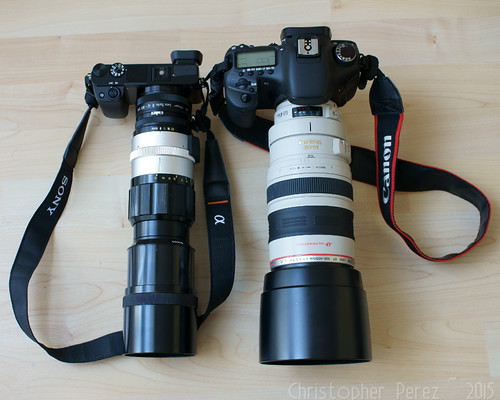
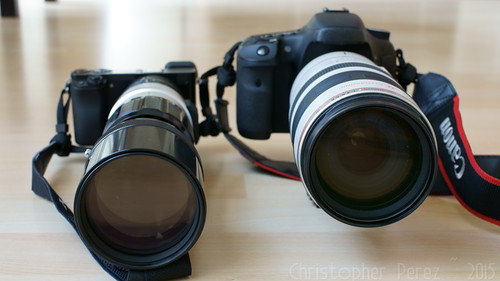
I was curious how a Nikon Nikkor 300mm f/4.5 H might compare against the much more recent and optically sophisticated Canon 100-400mm L f/4.5-5.6 super zoom.

Comparison scene setup
[shot with Sony NEX5, Nikon 50mm f/1.4, Lens Turbo II]
Checking the serial number of the lens I see that I was made during the early 1970's. The H model optic preceded Nikon's introduction of their extra low dispersion glass example by at least 3 years. Commenters across the 'net seem to rave about the 300mm ED, but not much enthusiasm is expended over the H. Well, as I said, I'm a sucker for a good looking lens.
The old Nikkor is nearly as heavy as the Canon L, though this is nicely offset by the smaller diameter lens barrels. I've found that a smaller lens size makes a lens easier for me to work with, even if the weight is similar to something with a large diameter barrel.
Being a fixed focal length lens, the Nikon is of course not as flexible the Canon zoom. But, since the Sony A6000 is APS-C and since I have a Lens Turbo II focal length reducer and a standard straight-thru Nikon to E-mount adapter I have two focal lengths to choose from when using the Nikkor - 300mm f/4 and 216mm f/3.2.

Size comparison
The Nikkor lens was set to it's closest focus point,
making the lens barrels extend to it's longest.
[shot with Sony NEX5, Sigma 30mm EX DN E]
Assuming for a moment that Sony introduces an in-body IS APS-C camera that solves the no-IS problem in using old lenses, the biggest thing I in the Sony/Nikkor kit give up is AF. I've come to love AF as it's most of the time more accurate than I am. The question is how accurate can I be at focusing the Nikkor? Would I be happy with the results?
The comparison setup was as follows -
- A very stout tripod (a Manfrotto somethingorother)
- Sony A6000 at 100ISO in "A" mode (aperture preferred)
- Nikon Nikkor 300mm f/4.5 H c.1972-ish
- Lens manually focused at 14x
- Nikon shot in two ways - with a straight-thru adapter and with a Lens Turbo II focal length reducer
- Canon 7D 18mpixel camera at 100ISO in "A" mode (aperture preferred)
- Canon 100-400mm f/4.5-5.6 L super zoom set to a field of view that nearly matched those of the Nikkor/Sony setup
- Canon contrast AF focusing in Live View
- Both lenses shot wide open and at f/8 (to see if the IQ improved by stopping down)
- 600x600pixel 100percent resolution image sections taken from the original scene (though I did not account for the file resolution differences between the 7D and A6000).
The results are...
[The following image links to my Flickr page. Look at this a full resolution to properly compare the various image sections.]

My observations include -
Nikon single-coated lens images are slightly lower contrast than the Canon zoom. However, it was very easy to match the contrast of the Canon lens in processing.
Canon's Live View AF system was a rather hit-or-miss affair. This is easily seen in the image comparisons. To think I've trusted the Canon AF system in the over 5 years I've owned the 7D. Having said that, using a (mostly) accurate very high speed AF system tied to image stabilization and focal-length flexibility makes for a very powerful kit.
If I can accurately focus my manual focus lenses the Sony A6000 offers 11fps burst rate whereas the 7D waltzes along at 8fps. Am I good enough to track and accurately focus moving targets? Time will tell.
The higher resolution Sony sensor (24mpixel vs Canon's 18mpixel) gives me a to be expected increase in the amount of information that can be used in the image file. The Sony file details are gorgeous and easy to work with. The sensor is the resolution limiting fact. Lenses typically out-resolve a sensor from wide open down through f/11.
From wide open, the Nikon 300mm f/4.5 H pre-Ai single-coated ancient as the hills ray-trace designed and mathematically calculated by hand lens is every bit the resolution match of the computer designed fluorite element Canon super-zoom.


Size comparison
The Nikkor lens was set to it's closest focus point,
making the lens barrels extend to it's longest.
[shot with Sony NEX5, Sigma 30mm EX DN E]
3 comments:
Bottom line: Any lens that can hit 80+ lp/mm is a match for a 24MP APS-C sensor.
My first sure-fire sharp but cheap lens for a Nikon D3200 was my Mamiya Sekor C 300/5.6 ULD. Yes, it's a slow lens.
Or ... my old lens corollary:
Fast, sharp, cheap (pick any two).
Lee - I've looked at this and the limit of a 24mpixel APS-C sensor is 118 lp/mm. To your point, most fixed focal length lenses can easily reach this. Even if things are a little soft wide open, stop down one or two clicks and everything becomes equal. Modern? Old? It doesn't seem to matter much. A great image can be made with just about anything. ;-)
Oops. Sorry. Let me correct something I just posted.
18mpixel APS-C sensors resolve 118 lp/mm
24mpixel APS-C sensors resolve 127 lp/mm
This means if a lens is truly diffraction limited, you might see a very slight image degradation at f/11 with the 24 mpixel sensor. With the 18 pixel sensor f/11 will not look degraded. In both cases all apertures above f/11 will resolve to the sensor limits.
Post a Comment